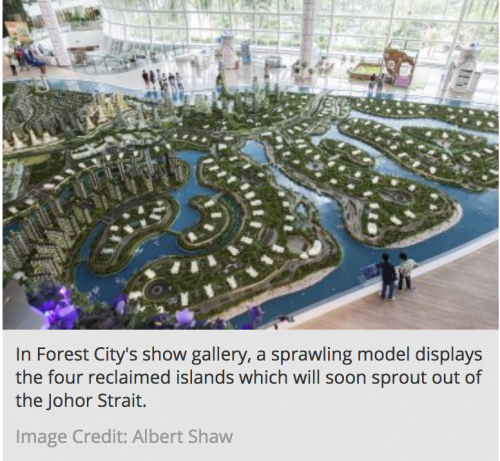Malaysia’s Forest City and the Damage Done

Malaysia’s Forest City and the Damage Done
While China has been reclaiming (wow euphemisms by the way) islands in the South China Sea to use as military bases, a 100 billion USD project called Forest City has been underway since 2014 in Johor, the southernmost state of Malaysia. It is not the only such project taking place in the Iskandar economic region, but it is far and away the most ambitious. The plan is to create four artificial islands in the waters of the Tebrau Strait, in the end covering an area of 14 square kilometers and bringing Malaysia’s shoreline closer to Singapore.
The project is in part financially supported by the Sultan Ibrahim Ismail of Johor, a well-respected figure protected by strict laws on lèse- majesté, or the insulting of a monarch/ other ruler. Because of this, some villigers facing resettlement and a loss of their livelihood are uneasy expressing their discontent.
This article does a great job at giving an overview of the ecological consequences of the Forest City project. Earthworks for Forest City’s four artificial islands began in 2014 without the legally required Detailed Environmental Impact Assessment (DEIA), and many local community members were not told about the start of reclamation work.
The Tanjung Kupang intertidal seagrass meadow, the largest of its kind in Malaysia, is directly affected by the reclamation work. Covering a total area of 36 square kilometers, the meadow lies only two hundred meters away from Forest City’s landscaped beach. As the project negatively impacts the health seagrass meadow, it simultaneously hurts the shoreline’s health. Some of the most diverse marine wildlife in the world will die off. Gleaners from Kampung Tanjung Kupang used to rely on the seagrass meadow to scavenge seashells, crabs and other small molluscs to complement their families’ meager meals, but this source of food is shrinking because of the reclamation work. Fisherman are struggling with significantly reduced catches and growing petrol costs from needing to travel through causeways and to more distant fishing grounds. Compensations for the local people are superficial in nature and do not inspire confidence in long-term solutions.
The fate of the Pulai River mangroves, essential for shoreline protection and flood prevention, is uncertain as rapid development and urbanization continues around the area. Villagers who rely on cutting and burning wood to work their artisanal charcoal kilms will be forced to relocate as a significant source of their income just disappears as the mangoves get pulled down. This part of the article is particularly poignant because it gives readers the image of a man standing in front of traditional earth kilns, being left behind as a new concrete world takes over.
This project is conducted by Country Garden Pacific View Sdn Bhd, a joint venture between Guangdong-based, Hong Kong-listed Country Garden Group and local partner Esplanade Danga 88 Sdn Bhd, a company partially owned by Sultan Ibrahim Ismail of Johor. I would be interested in looking further into China-led development in Southeast Asia, the consequent sentiments of Southeast Asians, the disparity between tradition and modernity, and the environmental consequences of such projects.
Comments
A parallel case study would be the development of the diamond island in Phnom Penh, Cambodia, where massive Chinese-owned luxurious housing complexes have displaced a considerable population of poor fishermen living in marshland by the river. I really appreciate your highlighting of the vignette of the man being left behind of a concrete world, an image that repeats itself over and over again in Southeast Asia. On the other hand, however, Chinese development projects are not naive economic investments. It will be useful to investigate the way in which Chinese’s no-string-attached investment policies are shaping the local people’s perception of modernity and industrialization while shifting the government’s political alignment away from the US toward the Chinese sphere.
Pages